PONTIAC BONNEVILLE 1993 Repair Manual
Manufacturer: PONTIAC, Model Year: 1993, Model line: BONNEVILLE, Model: PONTIAC BONNEVILLE 1993Pages: 322, PDF Size: 16.31 MB
Page 61 of 322
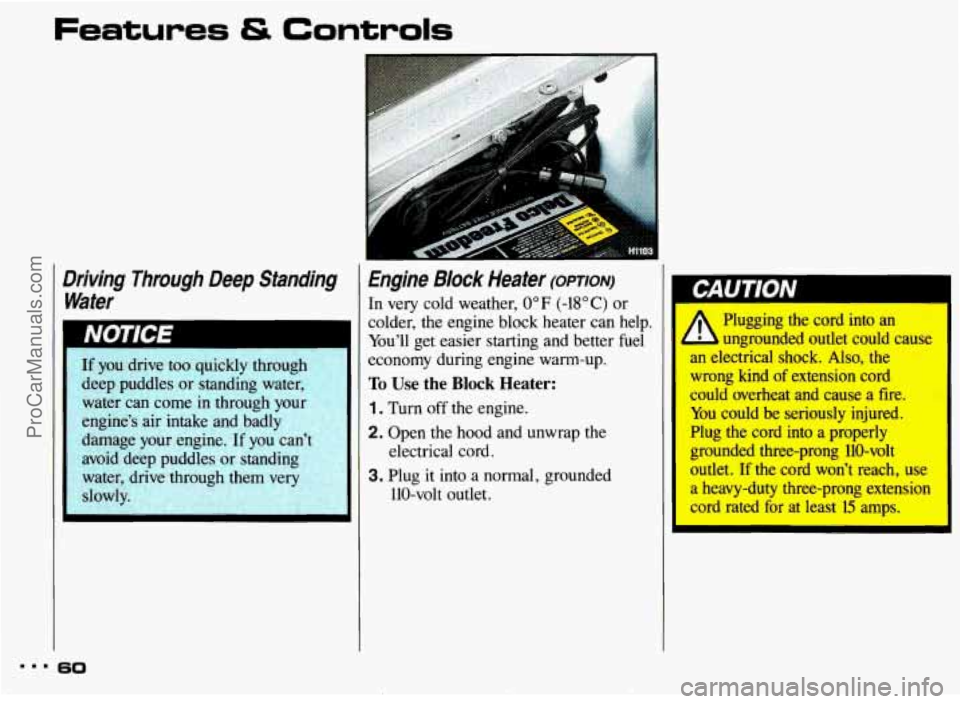
Features & Controls
Driving Through Deep Standing Water
.. - .
If you drive too quickly through
deep puddles or standing water,
water can come in through your
engine’s air intake and badly
damage
your engine. If you can’t
avoid deep puddles or standing
water, drive through them very
slowly.
Engine Block Heater (opTIoN)
In very cold weather, 0°F (-18” C) or
colder,
the engine block heater can help.
You’ll get easier starting and better fuel
economy during engine warm-up.
To Use the Block Heater:
1 . Turn off the engine.
2. Open the hood and unwrap the
3. Plug it into a normal, grounded
electrical
cord.
110-volt outlet.
b!!
A
Plugging the cord into an
ungrounded outlet could cause
an electrical shock. Also, the
wrong kind of extension cord
could overheat and cause a fire. You could be seriously injured.
Plug the cord into a properly
grounded three-prong 110-volt
outlet. If the cord won’t reach, use
a heavy-duty three-prong extension
cord rated for at least 15 amps.
... 60
ProCarManuals.com
Page 62 of 322
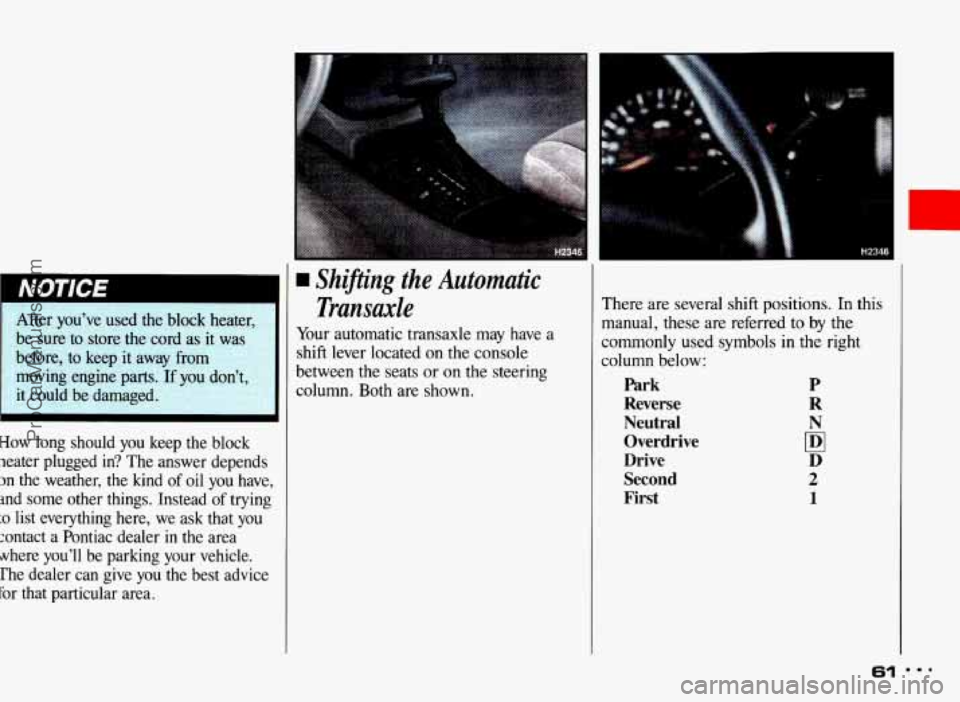
‘-- Transaxle
Shiftins
the Automatic I After you’ve used the block heater, __
be sure to store the cord as it was
column. Both are shown.
it could be damaged. between the seats
or on the steering
moving engine parts. If
you don’t, shift lever located on
the console
before, to keep it away from Your
automatic transaxle may have a
How long should you keep the block
Ieater plugged
in? The answer depends
In the weather, the kind of oil you have,
md some other things. Instead of trying
:o list everything here, we ask that you
:ontact a Pontiac dealer
in the area
ahere you’ll be parking your vehicle.
The dealer can give you the best advice
For that particular area. There are
several shift positions.
In this
manual, these are referred to
by the
commonly used symbols
in the right
column below:
Park
Reverse
Neutral Overdrive
Drive
Second
First P
R
N
IDI
D
2
1
61
ProCarManuals.com
Page 63 of 322
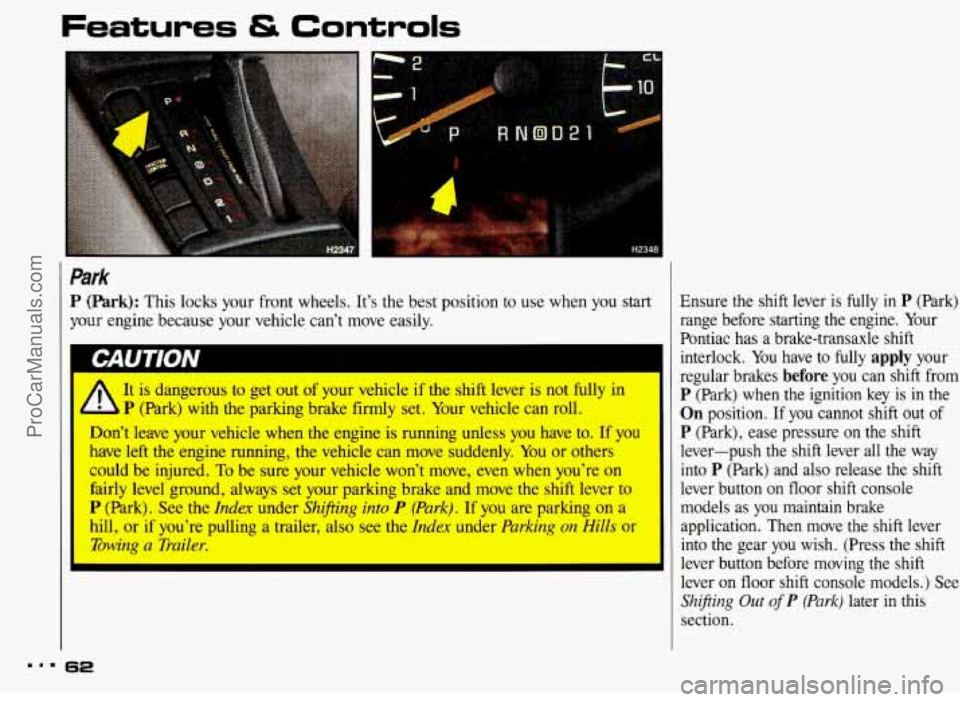
5 & Controls
Park
P (Park): This locks your front wheels. It’s the best position to use when you start
your engine because your vehicle can’t move easily.
1 It is dangerous to get out of your vehicle if the shift lever is not my in
Don’t leave your vehicle when the engine is running unless you have to. If you
have left the engine running, the vehicle can move suddenly. You or others
could be injured. To be sure your vehicIe won’t move, even when you’re on
fkirly level ground, always set your parking brake and move the shift lever to
P (Fark). See the Inda under Shiping into P (Park). If you are parking on a
hill, or if you’re pulling a trailer, also see the Inda under Parking on HilZs or
Towing a llailer.
- P (park) with the parking brake firmly set. Your vehicle can roll.
Ensure the shift lever is fully in P (Park)
range before starting the engine. Your
Pontiac has a brake-transaxle shift
interlock. You have to fully
apply your
regular brakes
before you can shift from
P (Park) when the ignition key is in the
On position. If you cannot shift out of
P (Park), ease pressure on the shift
lever-push the shift lever all the way into
P (Park) and also release the shift
lever button
on floor shift console
models as you maintain brake
application. Then move the shift lever
into the gear you wish. (Press the shift
lever button before moving the shift
lever on floor shift console models.) See
Shifting Out of P (Park} later in this
section.
I.. 62
ProCarManuals.com
Page 64 of 322
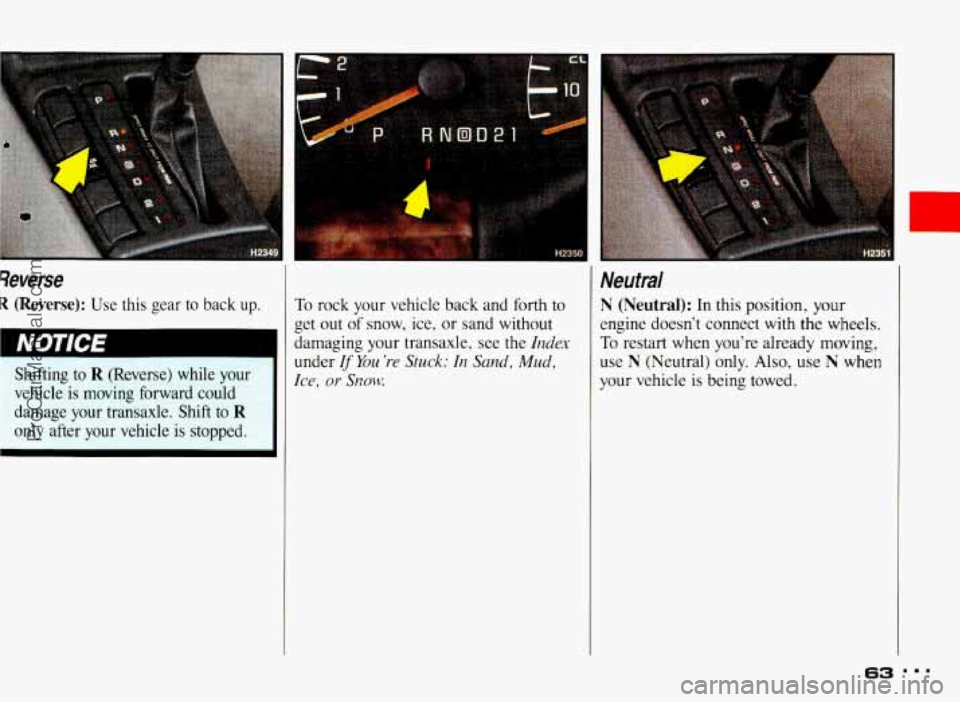
Severse
R (Reverse): Use this gear to back up.
Shifting to
R (Reverse) while your
vehicle
is moving forward could
damage your transaxle. Shift to
R
only after your vehicle is stopped.
To rock your vehicle back and forth to
get out
of snow, ice, or sand without
damaging your transaxle, see the
Index
under If You ’re Stuck: In Sand, Mud,
Ice, or Sy10w.
r
Neutral
N (Neutral): In this position, your
engine doesn’t connect
with the wheels.
To restart when you’re already moving,
use
N (Neutral) only. Also, use N when
your vehicle is being towed.
63 ..I
ProCarManuals.com
Page 65 of 322
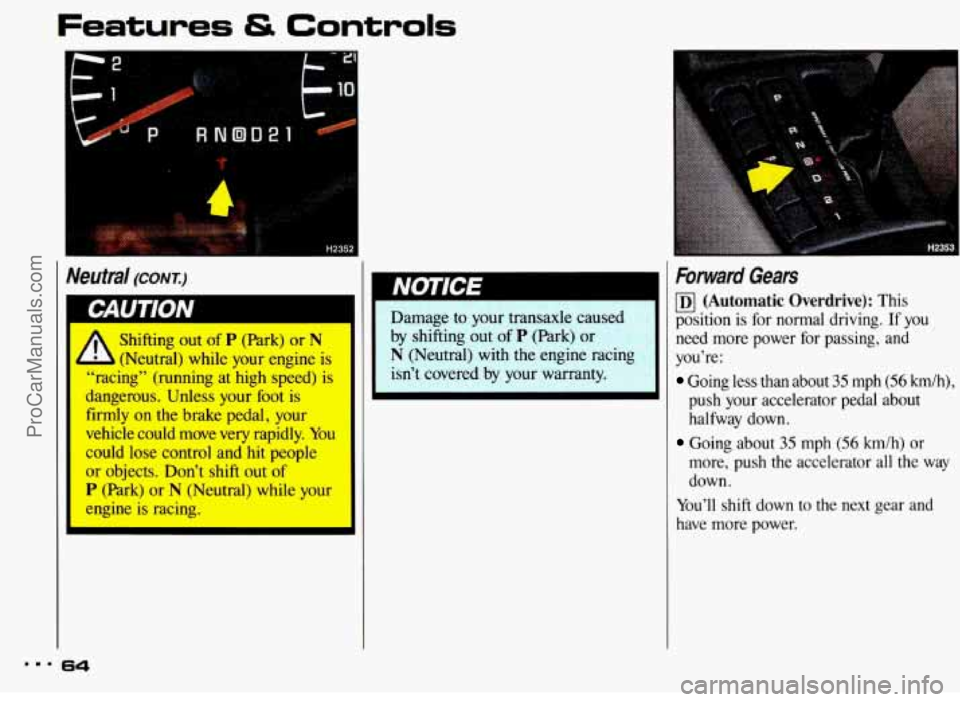
“r Controls
I Neutral (CONTJ
Shifting out of P (Park) or N
(Neutral) while your engine is
I “racing” (running at high speed) i: ’ ngerous. Unless your foot is
I llrmly on the brake pedal, your
vehicle could move very rapidly.
You
could lose control and hit people
or objects. Don’t shift out
of
P (Park) or N (Neutral) whill- --~ur
engine
is racin- Damage to your
transaxle caused
by shifting out
of P (Park) or
N (Neutral) with the engine racing
isn’t covered by your warranty.
Forward Gears
(Automatic Overdrive): This
position
is for normal driving. If you
need more power for passing, and
you’re:
Going less than about 35 mph (56 km/h),
push your accelerator pedal about
halfway down.
Going about 35 mph (56 h/h) or
more, push the accelerator all the way
down.
You’ll shift down to the next gear and
have more power.
... 64
ProCarManuals.com
Page 66 of 322
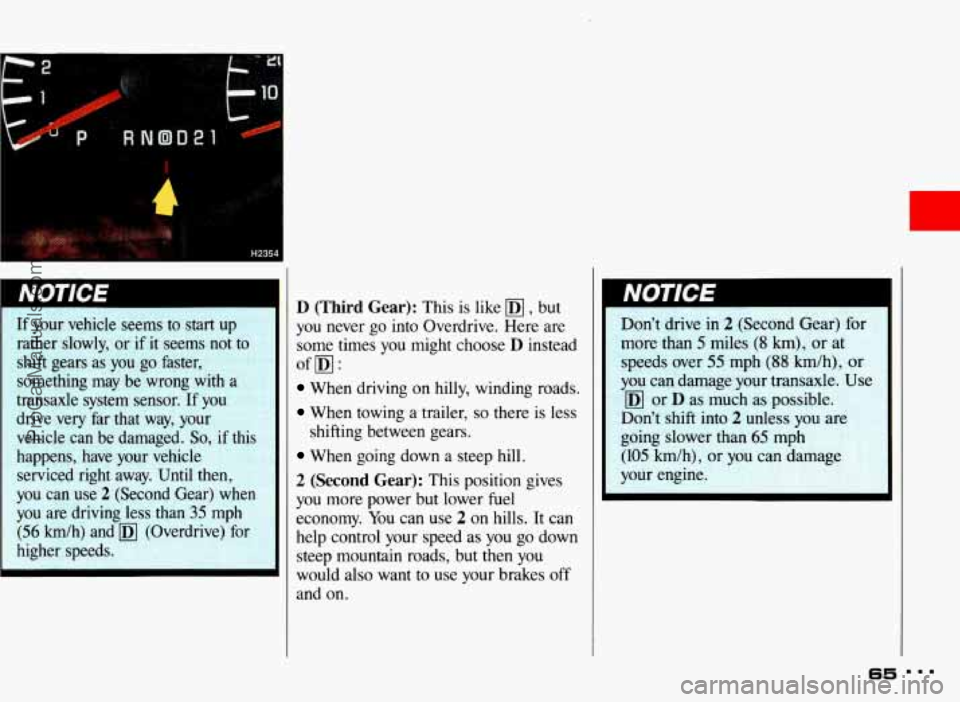
If your vehicle seems to start up
rather slowly, or if it seems not to
shift gears
as you go faster,
something may be wrong with a
transaxle system sensor. If you
drive very far that way, your
vehicle can be damaged.
So, if this
happens, have your vehicle
serviced right away. Until
then,
you can use 2 (Second Gear) when
vou are driving less than
35 mDh
i56 km/h) anza (0
higher speeds.
D (Third Gear): This is like , but
you never go into Overdrive. Here are
some times you might choose
D instead
When driving on hilly, winding roads.
When towing a trailer, so there is less
When going down a steep hill.
2 (Second Gear): This position gives
you more power but lower fuel
economy.
You can use 2 on hills. It can
help control your speed as you go down
steep mountain roads, but then you
would also want to use your brakes
off
and on.
ofm:
shifting between gears.
r
Don't drive in 2 (Second Gear) for I
more than 5 miles (8 km), or at
speeds over
55 mph (88 km/h), or
you
can damage your transaxle. Use
or
D as much as possible.
Don't shift into
2 unless you are
going slower than
65 mph
(105 km/h), or you can damage
your engine.
65 mmm
ProCarManuals.com
Page 67 of 322
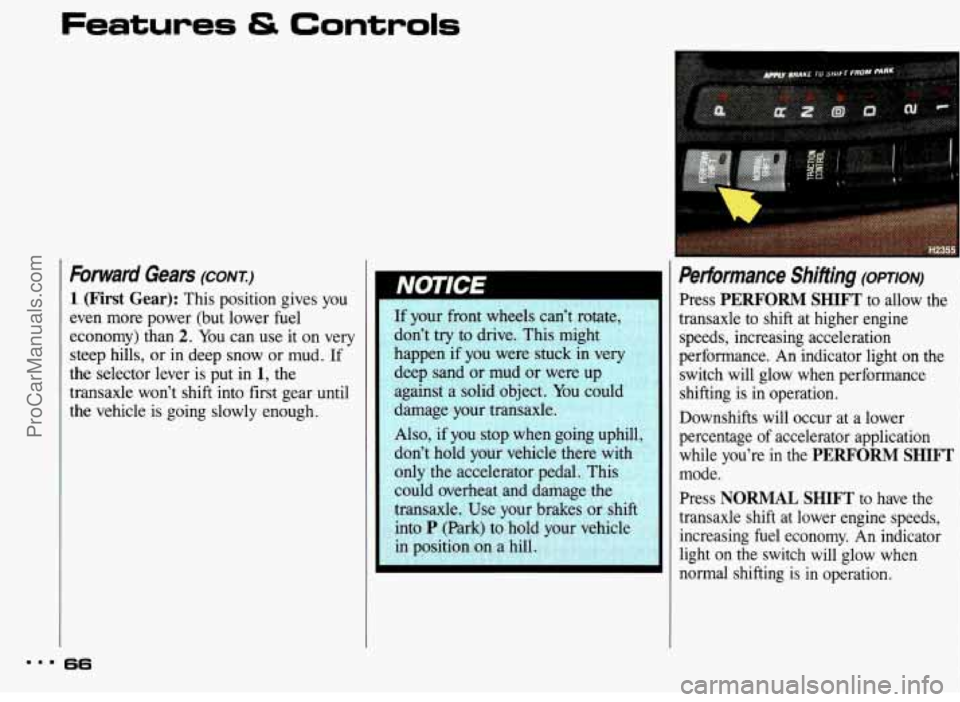
Features & Controls
Forward Gears (CONT.)
1 (First Gear): This position gives you
even more power (but lower fuel
economy) than
2. You can use it on very
steep hills, or in deep snow or
mud. If
the selector lever is put in
1, the
transaxle won’t shift into first gear until
the vehicle is going slowly enough.
66
If your front wheels can’t rotate,
don’t try to drive. This might
happen if you were stuck
in very
deep sand or mud or were up
against a solid object. You could
damage your transaxle.
Also,
if you stop when going uphill,
don’t hold your vehicle there with
only the accelerator pedal. This
could overheat and damage the
transaxle.
Use your brakes or shift
into
P (Park) to hold your vehicle
in position
on a hill.
Performance Shifting (opTIoN)
Press PERFORM SHIFT to allow the
transaxle to shift at higher engine
speeds, increasing acceleration
performance. An indicator light on the
switch will glow when performance
shifting is in operation.
Downshifts will occur at a lower
percentage
of accelerator application
while you’re in the
PERFORM SHIFT
mode.
Press
NORMAL SHIFT to have the
transaxle shift at lower engine speeds, increasing fuel economy. An indicator
light on the switch will glow when
normal shifting is in operation.
ProCarManuals.com
Page 68 of 322
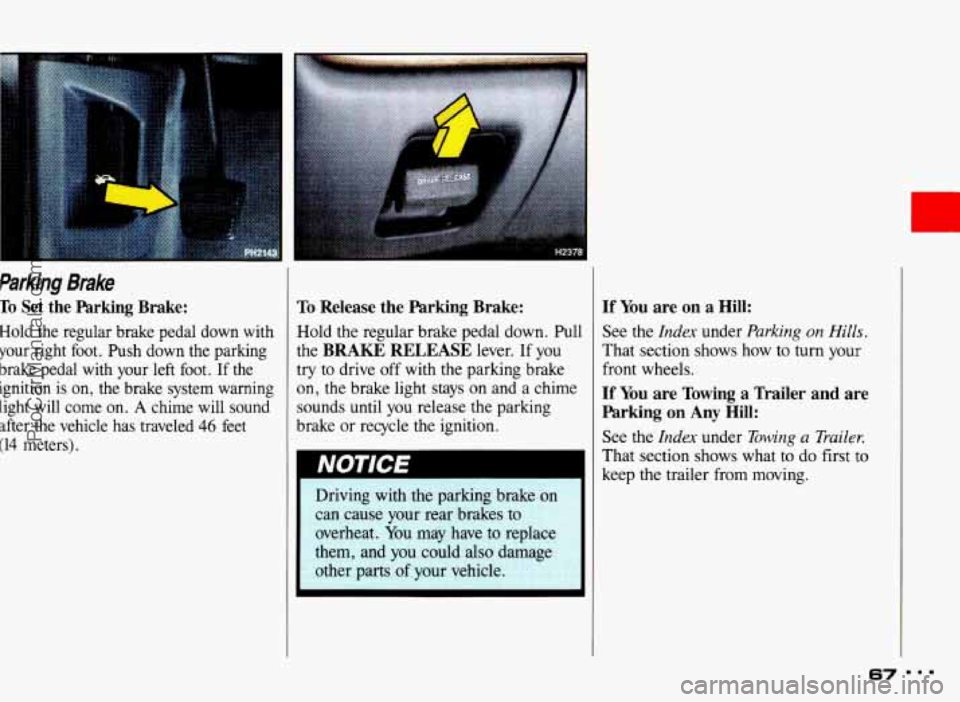
L-
Parking Brake
To Set the Parking Brake:
Hold the regular brake pedal down with
your right foot. Push down the parking
brake pedal with
your left foot. If the
ignition
is on, the brake system warning
light will come on.
A chime will sound
after the vehicle has traveled
46 feet
(14 meters),
To Release the Parking Brake:
Hold the regular brake pedal down. Pull
the
BRAKE RELEASE lever. If you
try to drive off with the parking brake
on, the brake light stays on and a chime
sounds until you release the parking
brake or recycle the ignition.
If You are on a Hill:
See the Index under Parking on Hitls.
That section shows how to turn your
front wheels.
If You are Towing a Trailer and are
Parking on
Any Hill:
See the Index under Towing a Trailer.
That section shows what to do first to
keep the trailer from moving.
67
c
...
ProCarManuals.com
Page 69 of 322
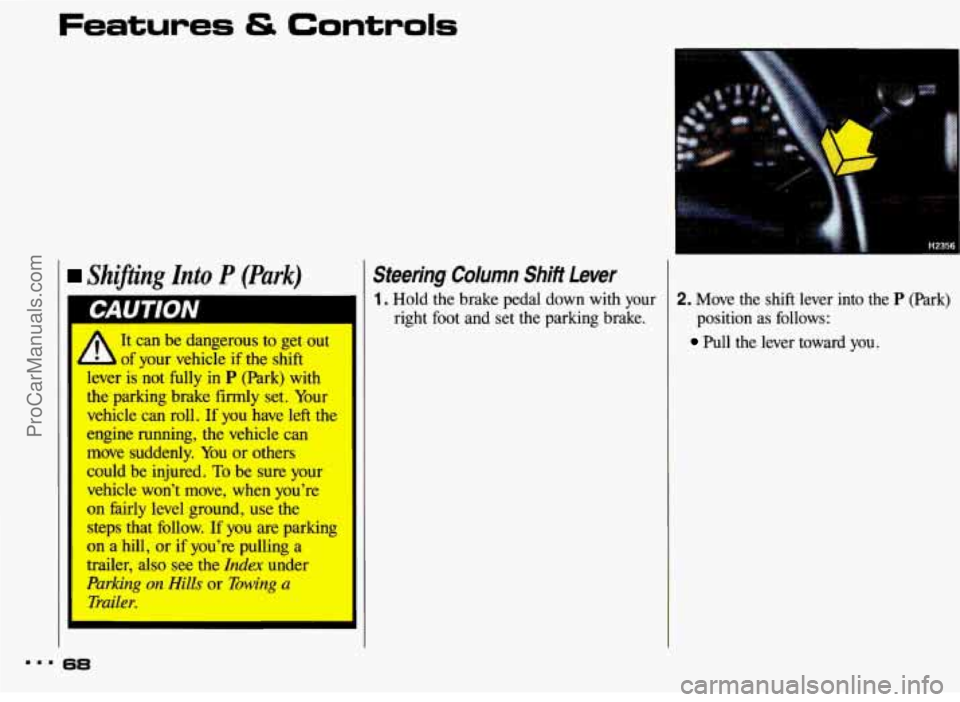
Features & Controls
1 Shifting Znto P (Park)
It can be dangerous to get out
~ b of your vehicle if the shift
lever is not fully
in P (Park) with
the parking brake firmly set. Your
vehicle can roll.
If you have left the
engine running, the vehicle can
move suddenly. You or others
could be injured.
To be sure your
vehicle won’t move, when you’re
on fairly level ground, use the
steps that follow. If you are parking
on a hill, or if you’re pulling a
trailer, also see the
Index under
rking on Hills or Towing a
rrailer.
Steering Column Shift Lever
1. Hold the brake pedal down with your
right foot and set the parking brake. 2. Move the shift lever into the P (Park)
position as follows:
Pull the lever toward you.
68
ProCarManuals.com
Page 70 of 322
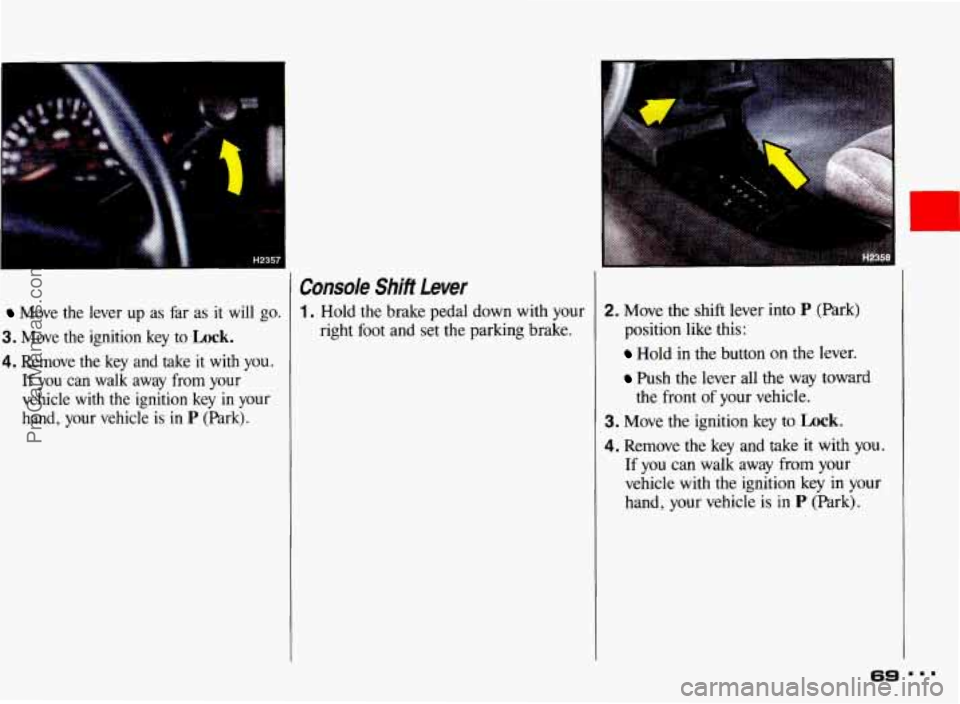
Move the lever up as far as it will go.
3. Move the ignition key to Lock.
4. Remove the key and take it with you.
If you can walk away from your
vehicle with the ignition key in your
hand, your vehicle
is in P (Park).
Console ShiR Lever
1. Hold the brake pedal down with your
right foot and set the parking brake. 2. Move the shift lever into P (Park)
position like this:
Hold in the button on the lever.
Push the lever all the way toward
the front of your vehicle.
3. Move the ignition key to Lock.
4. Remove the key and take it with you.
If you can walk away from your
vehicle with the ignition key in your
hand,
your vehicle is in P (Park).
69
ProCarManuals.com